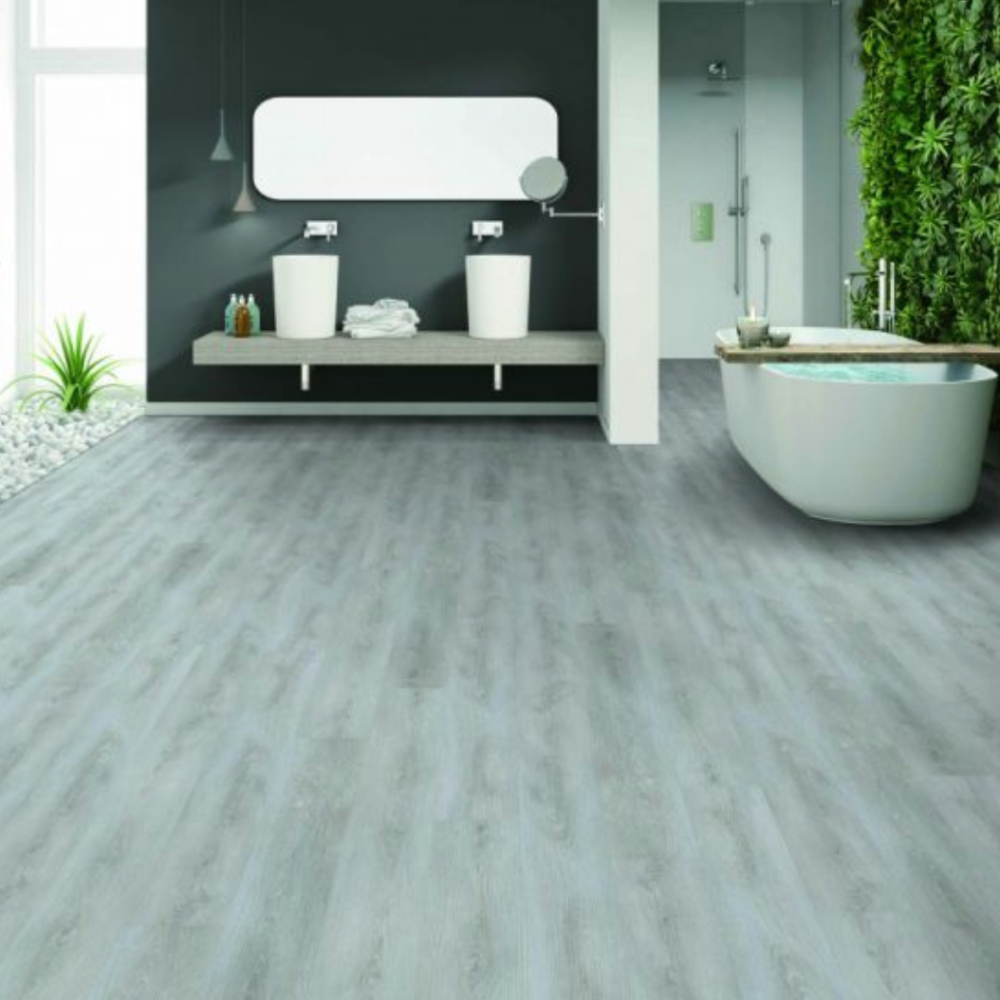Why solid wooden flooring in a bathroom isn't a good idea — plus, what to use instead
Although solid wooden flooring in a bathroom may look good on the surface, once water permeates you could end up with far from perfect floor say the experts. Instead, here's how to get the look without the risk
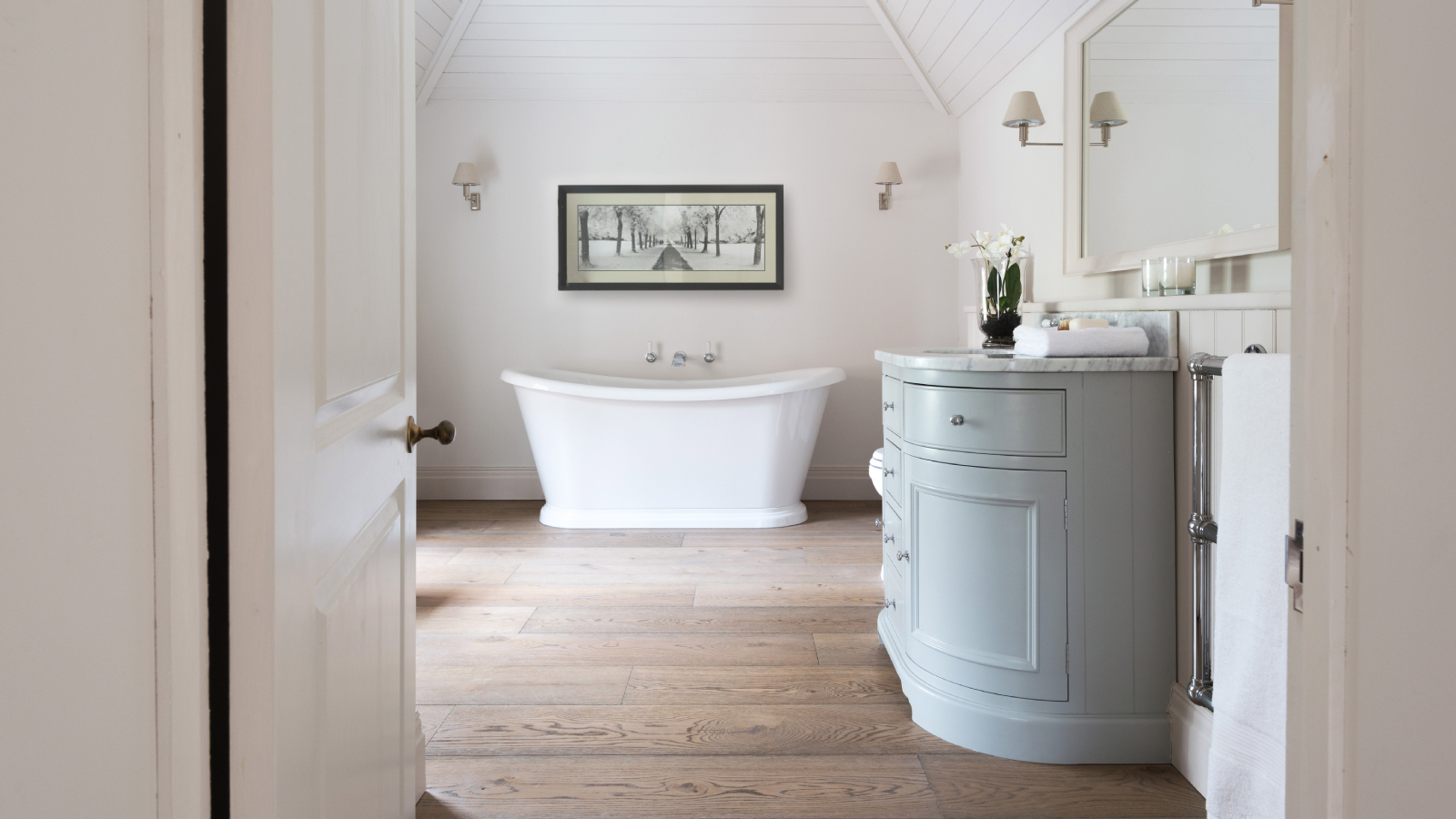
There's no denying that a solid wooden floor looks and feels great. But, when it comes to wooden flooring in a bathroom, the chances are it's not all it appears to be on the surface.
With water and humidity making a constant appearance in your washroom, your bathroom flooring ideas have a lot to live up to. As well as looking good, they need to perform well, last and ideally not need constant maintenance or repairs.
So, with solid wooden flooring one of the more expensive flooring options, is it worth investing in for your bathroom, or are you best spending your money on something else instead?
Wooden flooring in a bathroom: The basic rules
When it comes to wooden flooring in a bathroom, we've all seen images of bathrooms with what appears to be luxurious wooden floors, topped with luxurious freestanding bath ideas or providing a simple finish to a busy family bathroom.
So why are we saying that you can't have wooden flooring in a bathroom if you've seen it as a concept? It comes down to a basic understanding of the different types of wooden flooring.
“Hardwood is generally considered a poor choice for a bathroom as it is highly susceptible to water damage. It can warp or swell when exposed to moisture," advises Neel Bradham, CEO at global flooring brand, Parador.
Ian Tomlinson, MD, Chaunceys Timber Flooring agrees, telling us, "I would strongly advise against using solid wood flooring in bathrooms as it will soon distort due to the high humidity levels."
So, even though solid or hardwood flooring in bathroom is usually described as a no-no, what are the options to achieve the effect of wooden flooring in a bathroom without the risks?
The good news is there are plenty of options available that will offer the look and feel of wood but are designed and fitted in such a way as to reduce the chance of water permeating into the planks and destroying your bathroom design ideas.
"Despite the common misconception that wood flooring is unsuitable for rooms where water is frequently present, it can look fantastic in bathrooms as long as the correct type of wood flooring is chosen," confirms Ian Tomlinson, "and homeowners accept they need to take care to avoid leaving puddles on the floor, and to keep the room as well-ventilated as possible."
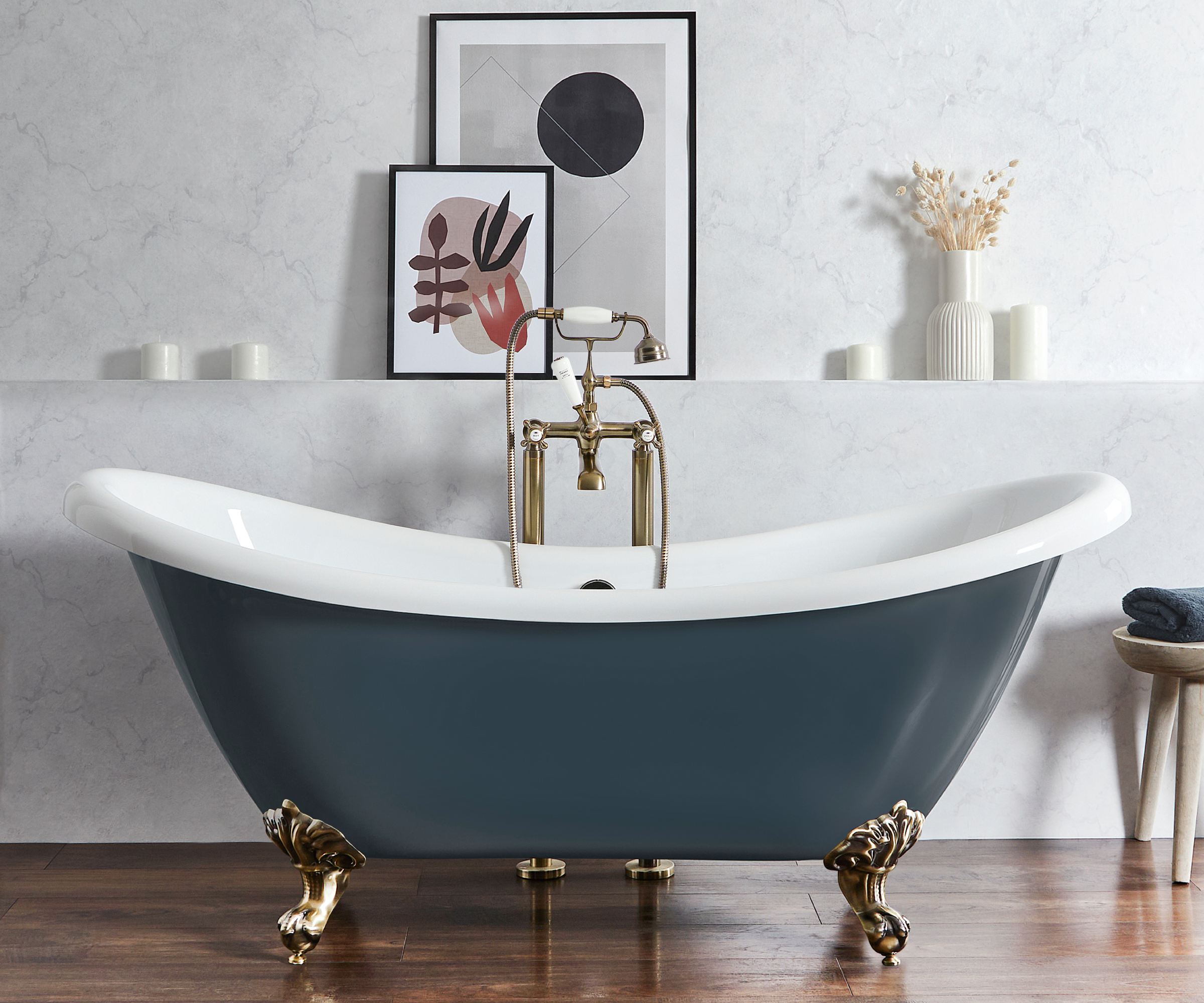

Neel Bradham is the CEO of Parador, a leading global flooring company since 1977. The brand redefines standards for the foundation of a beautiful room, changing perceptions about engineered wood, laminate, and vinyl floorings.

Chaunceys Timber Flooring is a family-run company based in Bristol with Ian becoming the Managing Director in 2012. They have been supplying sustainable, high-quality timber flooring to homeowners, award-winning architects, design and build companies, and renowned interior designers since 1988.
Engineered wooden flooring in a bathroom – pros and cons
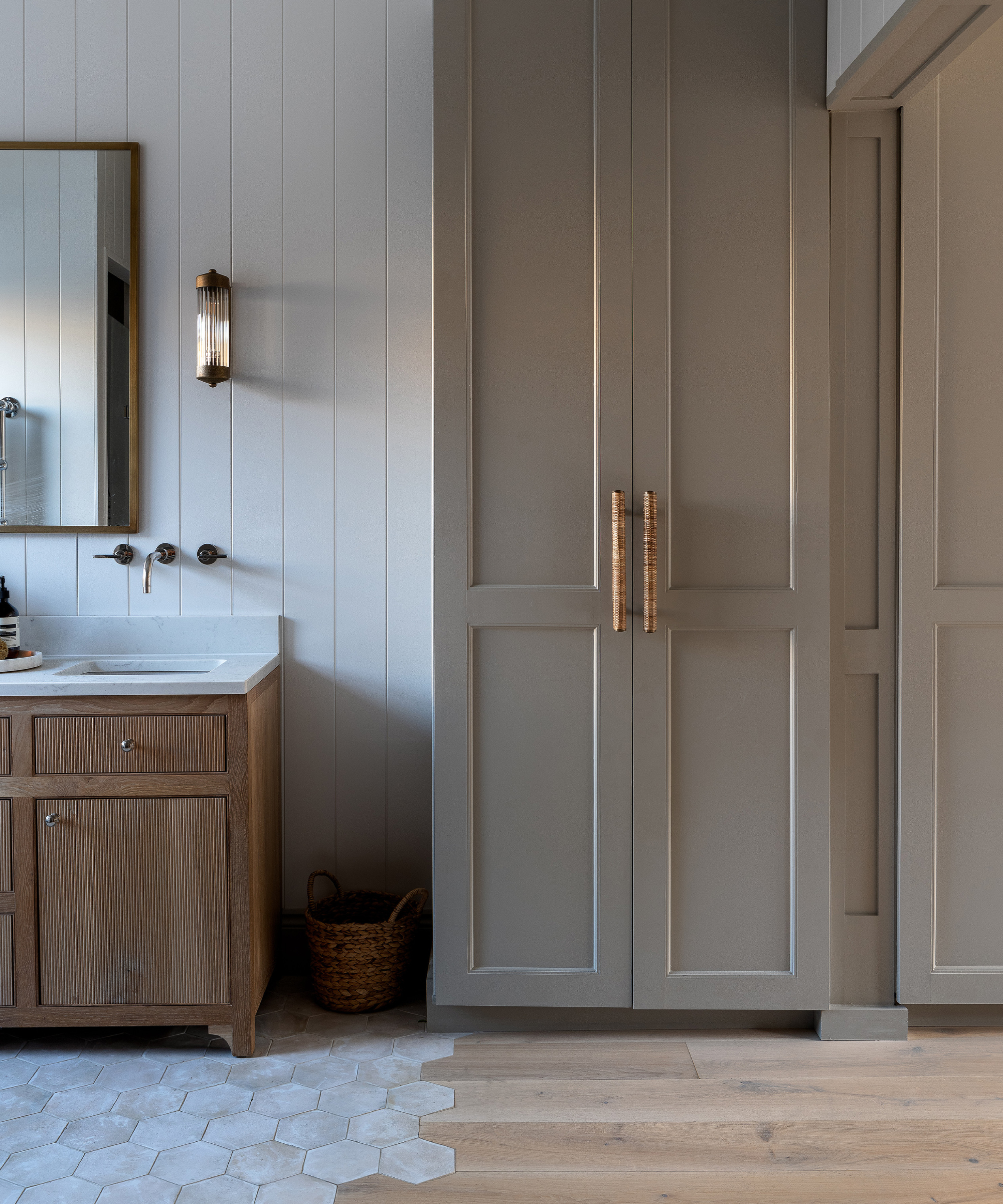
For a product that looks and feels like solid wood, your main option is engineered wood flooring. Made using layers of high density fibreboard or plywood, the planks are topped with a solid wood veneer, which means when made well, it's often confused for solid wooden flooring in a bathroom.
But, unlike solid wood, it's more resistant to the wear and tear of daily life explains Ian Tomlinson.
"High-quality engineered wood flooring is specifically designed to be extremely stable and tolerant to environmental changes. It is manufactured using state-of-the-art methods, allowing it to be used in a wide variety of situations, including installation above underfloor heating systems and in bathrooms," he says.
"Products such as our Bristol Tectonic® planks are perfect for a bathroom space as they combine a durable, high-quality European oak top layer with a high-grade birch ply base to create sustainable engineered oak flooring with exceptional stability."
Of course, as with any flooring system that has gaps – however small – there is the chance that water can permeate through and it's the same with engineered wood flooring. It's essential to ensure it's fitted well and any water spills or excess moisture are removed from the area. Good bathroom ventilation is essential to help increase the product's longevity which is costlier than other wood effect products such as laminate.
Laminate wooden flooring must be waterproof
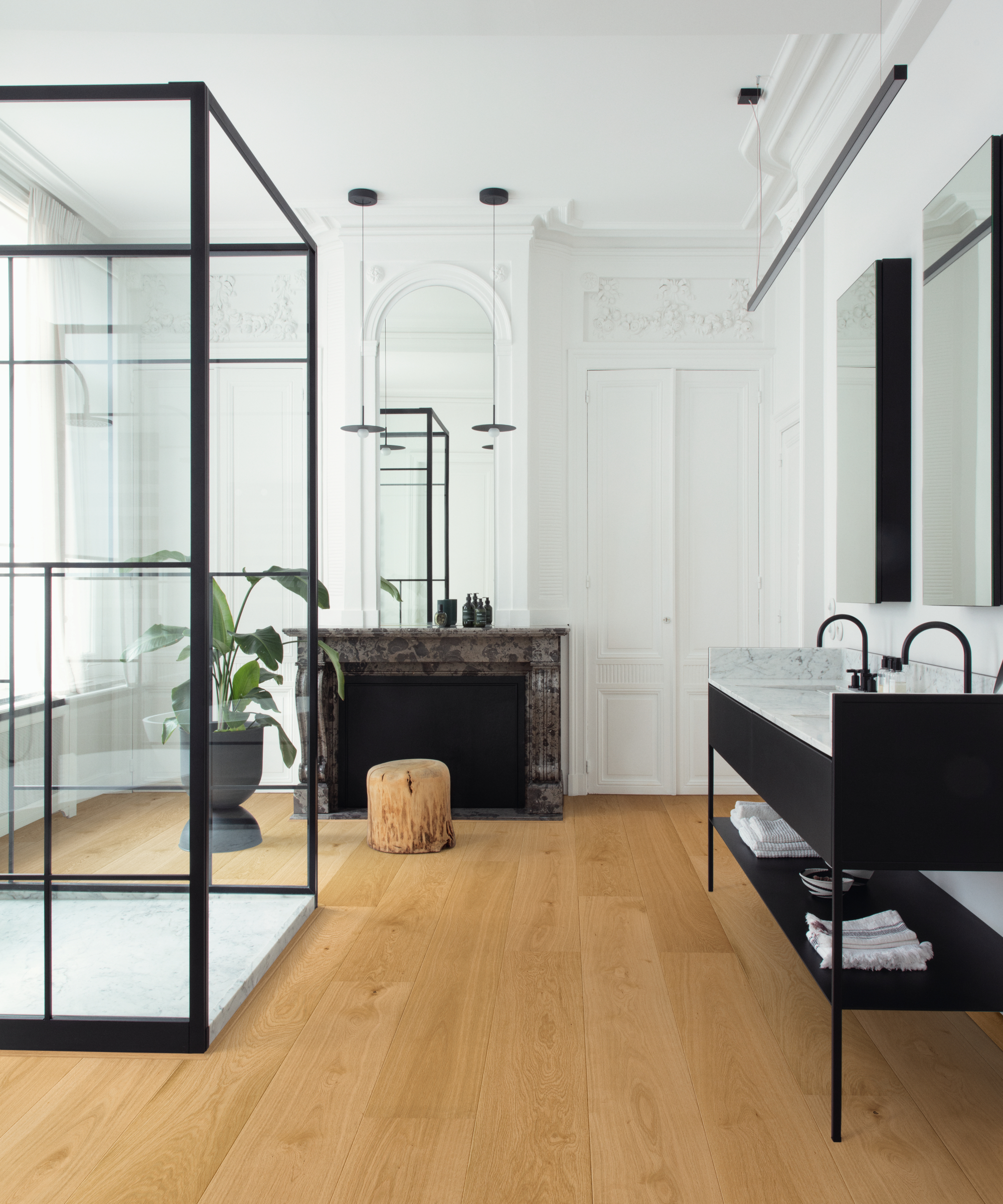
If your bathroom costs are spiralling, but you still want a wooden floor finish, you may be considering laminate flooring as a cheaper option for your bathroom renovation.
However, in most instances, flooring experts will tell you this could turn out to be false economy, especially if you choose a budget option as the answer to 'is laminate waterproof?' is generally no, with some exceptions.
While it's certainly cheaper than engineered wood, a non waterproof version will always be prone to water ingress and you could end up replacing it far sooner than any other options. Once water works its way into the seams of laminate flooring it will start to warp, making daily bathroom life a minefield, let alone keeping it clean.
However, if you pick a laminate flooring that's waterproof, such as this Quick-Step Salto Mayfair Light Grey Oak from Wickes, it's considered suitable for use in bathrooms.
Luxury vinyl tile flooring – wood effect but without the risk
If you've ever researched types of vinyl flooring, you'll have discovered the world of luxury vinyl tile (LVT) flooring where all is not as it seems – but in a good way.
Design and technology has advanced in such a way that LVT flooring is hard to distinguish from other products such as wood and tiles when you look at it – although once you set foot on it it's of course easier to establish.
"Known for its resistance to moisture and climate, LVT is ideal for both bathrooms and kitchens," explains Neel Bradham. "It provides the patterns, colours, and textures of natural wood (and concrete or marble) while being suitable for areas that may often endure excess moisture and spills.
"Vinyl flooring is still struggling to shake off its passé reputation, but beautiful, natural-looking LVT designs are now commonplace, and modern manufacturing techniques allow the flooring to be made in different formats, such as tiles and planks, making it ideal for those looking to have the look of wooden flooring in a bathroom."
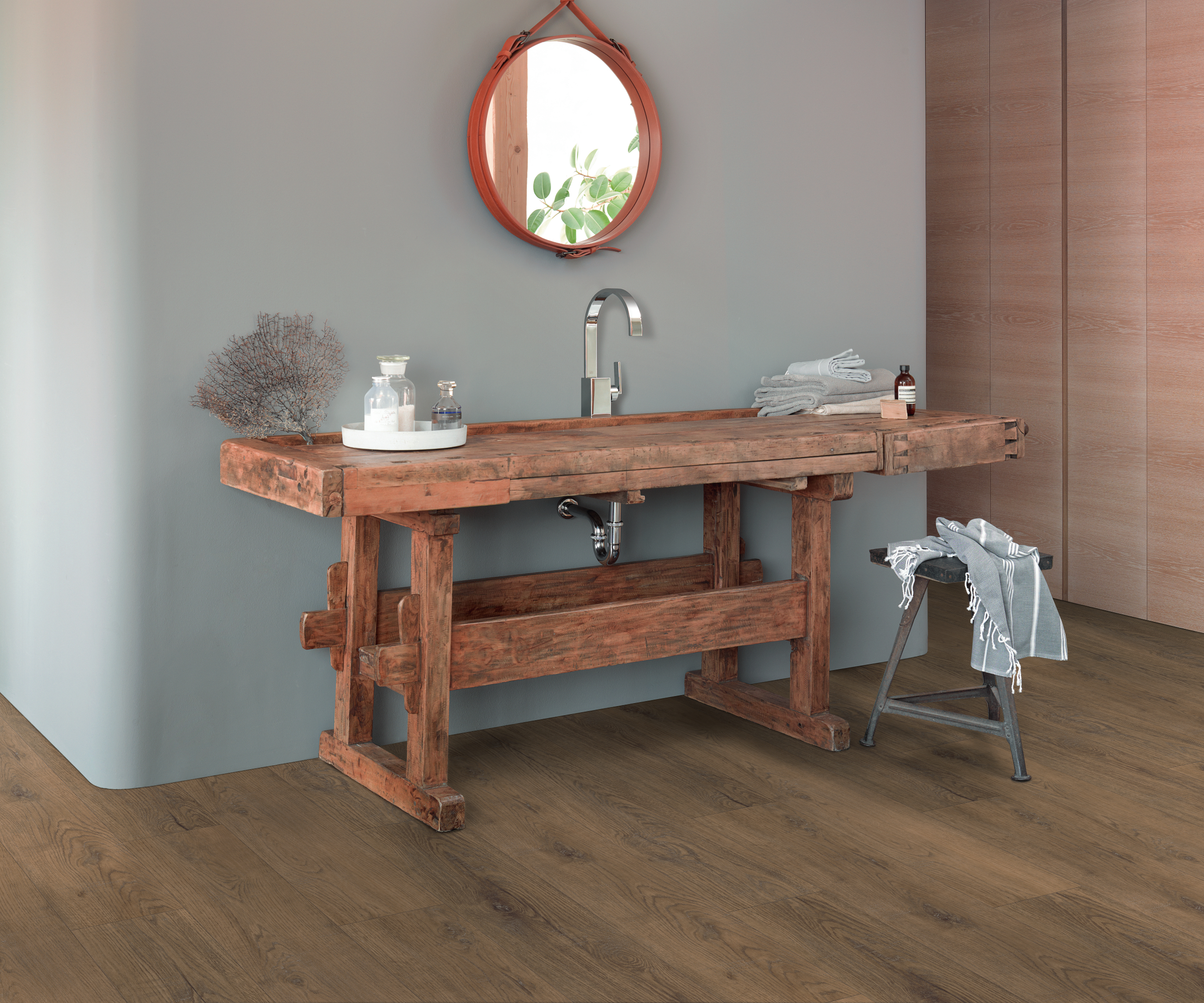
Wood effect tiles – hardwearing and visually appealing
Bathroom floor tile ideas are generally considered the most suitable when choosing your bathroom flooring. Water resistant, easy to maintain and clean, hard wearing and ready to deal with most bathroom activities, they are again another potential option if you're looking to create the wooden flooring in a bathroom vibe.
Although, as with LVT, if the feel of wood underfoot is top of your list, you won't really get this from a tile. But, if longevity and appearance matter most, this could be another great option to consider.
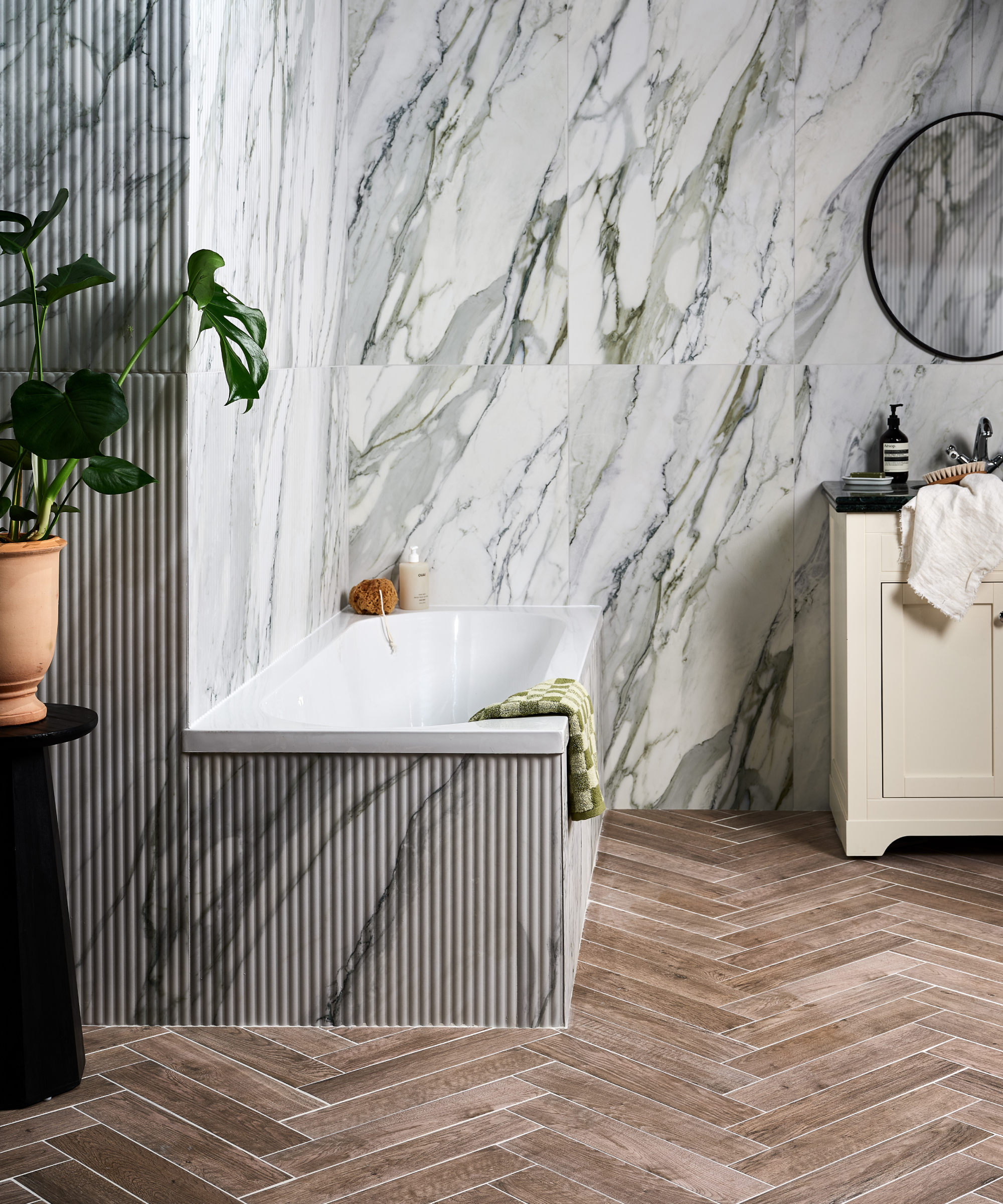
Shop for wooden flooring in a bathroom
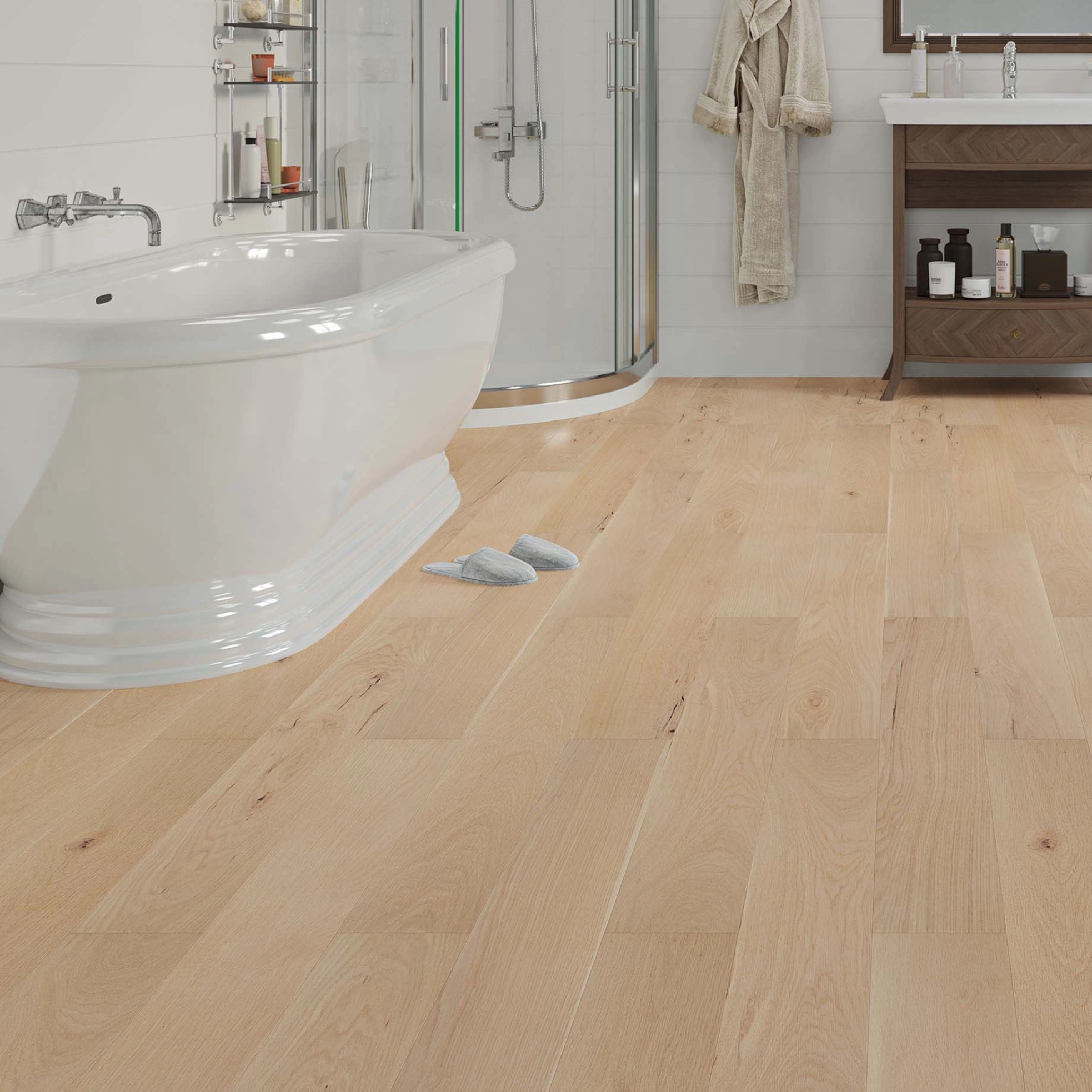
A engineered wood floor with a real wood top layer backed with a waterproof stone-based core
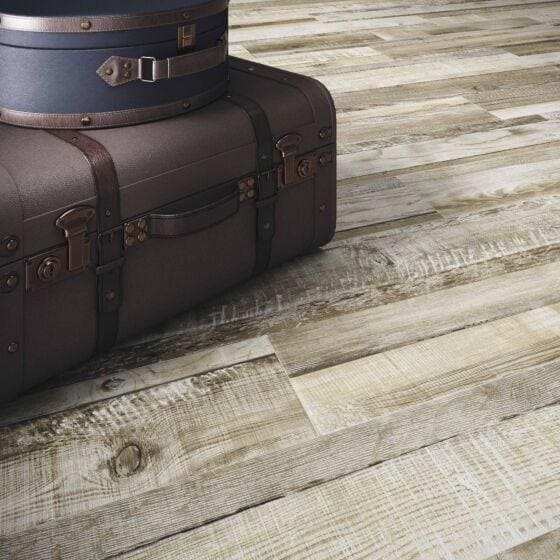
A rustic wood effect porcelain tile perfect for a cottage country bathroom design
Installation and maintenance tips for wooden flooring in a bathroom
If you are forging ahead and installing wooden flooring in your bathroom, how can you make sure it's installed correctly and cared for in the right way?
"Firstly, ensure installation is carried out by a professional – this is no job for a DIYer," says Darwyn Ker, managing director of Woodpecker Flooring. "A professional will ensure the wood is properly acclimatised to the bathroom’s humidity levels before installation. This will prevent shrinkage and warping.
"Homeowners also need to ensure the subfloor is completely dry and level so moisture doesn’t seep into the flooring from below," he adds.
"A moisture barrier between the subfloor and flooring may also be applied, and a waterproof sealant will need to be added to the wood. This will need to be reapplied to maintain its effectiveness. Any spills and excess water from the shower or bath will also need to be cleaned immediately. But don’t use abrasive cleaners, as this could damage the sealant," he warns. "Waterproof sealants will also need to be applied regularly to ensure it remains effective in humid conditions."
However, in line with our other experts, Darwyn confirms that, "solid wood floors are not suitable for bathrooms. And while engineered wood flooring may be a consideration, as long as it is installed properly and regularly maintained, realistically, composite boards with a wood-effect finish are the best option."
Other flooring options such as vinyl and tiles also require less cleaning, although extra advice is available for cleaning LVT and sprucing up your tile grout.
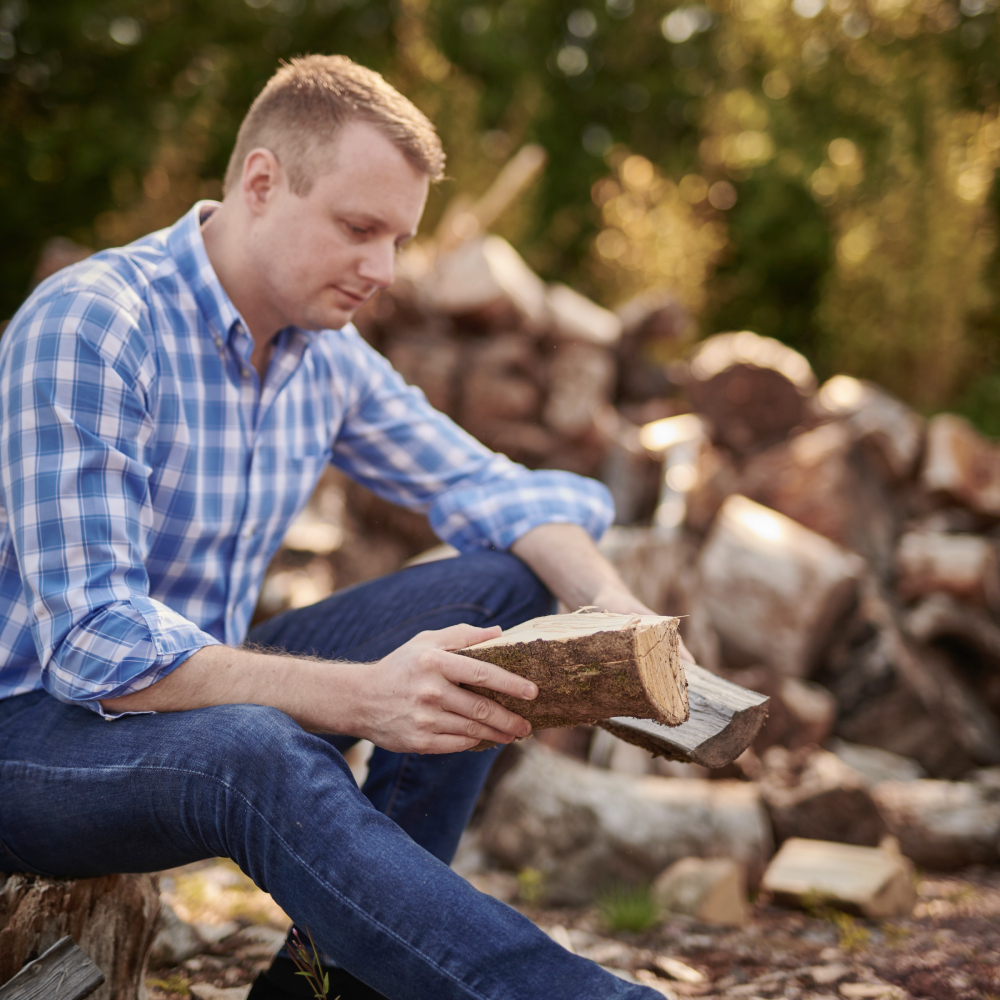
Darwyn Ker grew up in the timber industry. From the earliest memories immersed in the hands-on production of wood flooring from the late 1990s to the early 2000s when production was moved to France and spread out to now 10 locations across the world. He is incredibly passionate about the personality, character, life, ambience, and atmosphere wood floors bring into any home or space.
Wondering what are your options for updating your bathroom flooring in the future if you change your design ideas? Find out the answer to can you sand engineered wood flooring and if you're embarking on a DIY bathroom remodelling project, follow the advice in how to fit an engineered wood floor.
Get the Homebuilding & Renovating Newsletter
Bring your dream home to life with expert advice, how to guides and design inspiration. Sign up for our newsletter and get two free tickets to a Homebuilding & Renovating Show near you.

Sarah is Homebuilding & Renovating’s Assistant Editor and joined the team in 2024. An established homes and interiors writer, Sarah has renovated and extended a number of properties, including a listing building and renovation project that featured on Grand Designs. Although she said she would never buy a listed property again, she has recently purchased a Grade II listed apartment. As it had already been professionally renovated, she has instead set her sights on tackling some changes to improve the building’s energy efficiency, as well as adding some personal touches to the interior.
